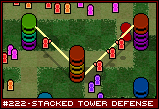|
Mechanic #222 - Stacked Tower Defense |
 | Posted: Jun 22, 2016
A tower defense game where the towers are built by stacking modules on top of each other. |
![[stack1.png]](set12/img/entry222-stack1.png)
Fig 222.1 - Tower Defense.
This is a tower defense style game where the towers are actually a stack of specialized modules. The best way to think about it is that you are basically playing three separate tower defense games simultaneously, in three different layers.
![[stack3.png]](set12/img/entry222-stack3.png)
Fig 222.2 - Tower Building.
Towers are built by dropping tower pieces from the top. If a piece from the bottom or middle is removed or destroyed, the layers above it will fall down to take its place. Tower elements can destroy themselves because of some criteria, such as running out of ammo, counting a specific number of enemies walking past, due to a timer, or whatever. You build the towers at the beginning of the level and that's it. You, as a player, don't get to interact with them while the level is playing out. As such, if you need the towers to change or not change during the game, you need to plan accordingly.
![[stack2.png]](set12/img/entry222-stack2.png)
Fig 222.3 - Enemy Types.
Each of the enemy types you encounter will exist in one or more layers simultaneously. A regular sized guy will exist on the ground layer and be targeted by the bottom level of the tower. A larger enemy will exist in the bottom and middle layers, with the bottom level of the tower attacking his body, while the middle layer attacks his head (maybe some enemies are wearing body armor and some enemies helmet, making each part stronger or weaker to attack). Flying enemies may exist at the topmost layer, while flying enemies carrying something will exist in the top two layers.
Perhaps there could be a vehicle where the bottom level is the tires, the middle layer the vehicle's body, while the top layer is the driver.
![[stack4.png]](set12/img/entry222-stack4.png)
Fig 222.4 - Connecting Towers.
The towers are not just there to shoot at the passing enemies. They also are related to each other. You can build wires between levels on different towers in order to connect them. In this way, you can supply troops and power to alternating towers, such that you don't have to waste a level on barracks or power supplies for each stack. The little guys will climb across the wires to each stack where needed, carrying supplies, ammo, and technology with them.
![[stack5.png]](set12/img/entry222-stack5.png)
Fig 222.5 - Manipulating Enemies
Unlike traditional tower defense games, during which a progression of enemies attack in waves, traveling from one point to your base, this is more of a puzzle game where all the enemies start on the map and it is your job to eradicate them all within two minutes. Due to the nature of the enemies and the different layers, you must device a system for best attacking them in the proper order, and manipulating them down various paths.
For example, one tower element could be a magnet. If placed on the bottom layer, it will draw enemies with body armor down that path. Placed in the second layer, it will affect enemies with metal helms. You can use this magnet element to draw a certain class of enemies away from others to a path or loop where you have specifically created a sequence of towers designed to disarm them and then kill them.
For a second example, you could have one element be a simple blockade, which causes enemies to move either left or right rather than going forward. Placed at the highest level, flying enemies would be moved while anything shorter would continue straight. Put it in the middle layer and flying enemies will drop whatever they are carrying as they run into it.
If you don't manage to solve the order of operations needed to finish the job, you start over while keeping the towers you have already built. In later levels, there could be multiple consecutive waves with different requirements, such that you need to create towers the transform under certain circumstances to update to the requirements of the next wave. You only build at the beginning of a level. It is out of your control after that.
![[prototype]](set12/img/entry222-prototype.png)
Click for Prototype Note.
|